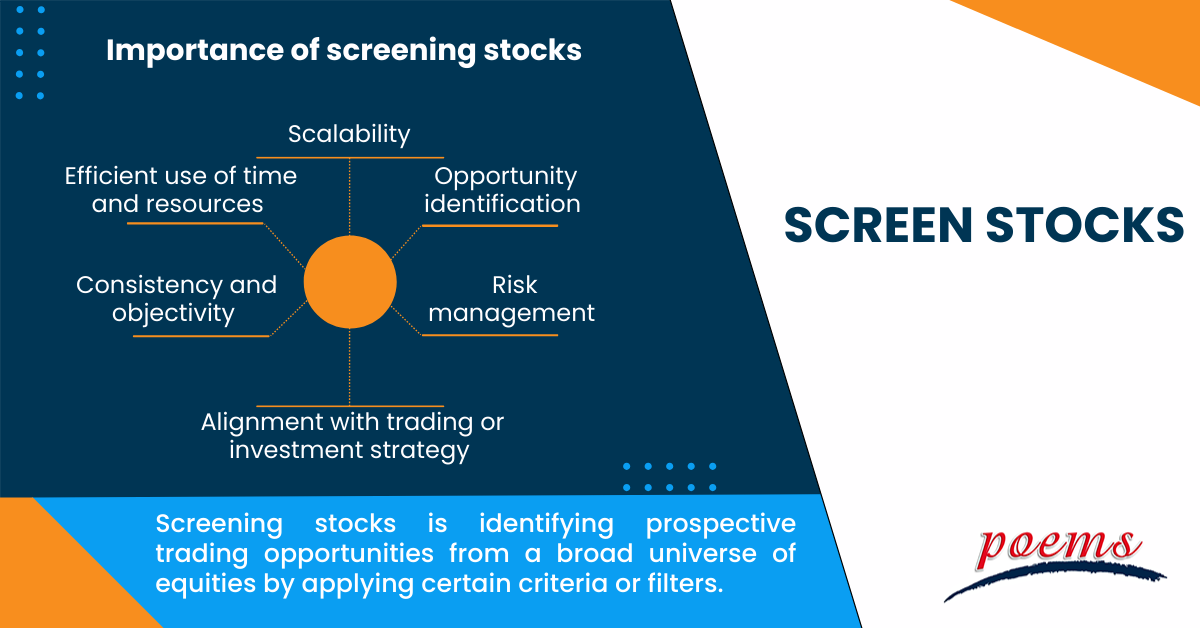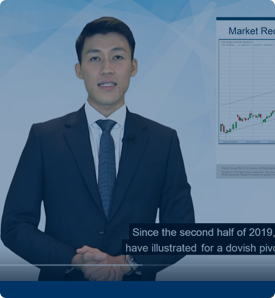Screen stocks
Table of Contents
Screen stocks
Choosing outstanding stocks has become a challenge. The sheer number of firms makes identifying a solid stock tough, and the amount of data available on the internet doesn’t help matters. It’s difficult to separate the relevant information from the useless data. Fortunately, a stock screener can assist you in focusing on stocks that satisfy your criteria and fit your approach. Stock screeners are useful filters when you’ve got a clear notion of the kind of firms in which you want to invest. There are thousands of equities registered on exchanges in the United States and it is impossible to keep track of them all. Thus, a stock screener narrows your involvement to only those stocks that fit your specific criteria.
What is the screening of stocks?
Screening stocks is identifying prospective trading opportunities from a broad universe of equities by applying certain criteria or filters. Traders use screening procedures to focus their attention on a small set of equities that fulfil their predefined criteria. Investors or traders frequently use screening devices or programmes to ease the process of discovering equities that match their investment goals or strategy. They may generate a customised list of stocks that fulfil their chosen criteria by adding certain filters, allowing them to analyse and make investing decisions.
Understanding the screening of stocks
Stock screening aims to simplify the share selection process and find equities that correspond to specified trading or investing strategies. Traders may rapidly build a list of equities that fulfil their desired features by applying predetermined filters or criteria, allowing them to simply analyse and make educated selections.
The purpose of screening stocks is to streamline the stock selection process and identify stocks that align with specific trading or investment strategies. By applying predefined filters or criteria, traders can quickly generate a list of stocks that meet their desired characteristics, making it easier to analyse and make informed decisions.
Importance of screening stocks

Screening stocks is important for several reasons:
- Efficient use of time and resources
With thousands of stocks in the market, screening allows traders and investors to focus on a smaller subset of stocks that meet their specific criteria. This saves you effort and time that would otherwise be spent manually reviewing many stocks, allowing for more efficient analysis and decision-making.
- Alignment with trading or investment strategy
Screening stocks enables traders and investors to filter out stocks that do not align with their trading or investment strategies. By setting specific criteria, they can identify stocks with the characteristics they seek, such as high-growth potential, value stocks, dividend-paying stocks, or stocks from specific sectors or industries.
- Opportunity identification
Using screening techniques, traders can uncover potential opportunities that meet their desired criteria. Whether identifying stocks with specific technical patterns, undervalued stocks, or stocks with strong fundamental metrics, screening helps identify stocks with a higher probability of generating profits or meeting investment objectives.
- Risk management
Screening stocks allows traders and investors to incorporate risk management strategies into their decision-making process. By applying filters for factors like volatility, liquidity, or specific risk metrics, they can avoid stocks that carry higher risk levels or do not fit their risk tolerance. This can help protect against potential losses and promote a more balanced portfolio.
- Consistency and objectivity
By using a systematic screening process, traders and investors can approach stock selection consistently and objectively. It reduces the influence of emotions or biases in decision-making and ensures that stocks are evaluated based on predefined criteria rather than subjective opinions.
- Scalability
Screening stocks is particularly valuable for traders or investors who want to scale their operations or manage larger portfolios. By utilising screening tools or software, they can efficiently analyse a larger number of stocks and identify opportunities across a broader range of the market.
Example of screening stocks
A real-world example of screening stocks in the US is the S&P 500 index, which includes the top 500 companies in the US based on market capitalisation, liquidity, and other factors. Investors can use this index to screen stocks based on their sector, performance, and other parameters.
Screening stocks can help investors make informed investment decisions and build a diversified portfolio.
Frequently Asked Questions
Stock screeners have several limitations, such as:
- Most stock screeners just take into account numerical criteria. There are still a lot of qualitative considerations. No screener details issues like open legal cases, labour issues, or consumer satisfaction levels.
- Databases used by screeners are updated according to various timetables. Always verify the data’s accuracy and relevancy. Your search can be fruitless if a screener’s data isn’t up to date.
- Watch out for blind spots that are industry-specific. For instance, don’t anticipate many tech businesses coming up if you search for low P/E valuations.
If you are looking for a detailed list of screened stocks, several resources are available. One of the most popular options is a stock screening tool, which allows you to filter stocks depending on many factors including market capitalisation, price-to-earnings ratio, dividend yield and more. Many free and paid screening tools are available online, including those offered by major financial websites like Yahoo Finance and Morningstar.
The term “screen” can describe assessing and choosing investment prospects based on predetermined criteria or filters. Investment screening uses predetermined criteria to filter and reduce the universe of prospective investments to a more manageable fraction that complies with certain standards.
The procedure of day trading starts with screening. Once you have a list of stocks that could be acceptable, more investigation and ongoing monitoring are required to pinpoint particular trading opportunities, establish entry and exit points, and successfully manage risk.
While stock screening can be useful, it shouldn’t be the only foundation for making investment decisions; it’s crucial to remember. Typically, screening comes first in a larger study and analytical process. To make wise financial judgements, further research, a basic analysis, and consideration of qualitative elements are essential.
Related Terms
- Options expiry
- Payment Date
- Treasury Stock Method
- Reverse stock splits
- Ticker
- Restricted strict unit
- Gordon growth model
- Stock quotes
- Shadow Stock
- Margin stock
- Dedicated Capital
- Whisper stock
- Voting Stock
- Deal Stock
- Microcap stock
- Options expiry
- Payment Date
- Treasury Stock Method
- Reverse stock splits
- Ticker
- Restricted strict unit
- Gordon growth model
- Stock quotes
- Shadow Stock
- Margin stock
- Dedicated Capital
- Whisper stock
- Voting Stock
- Deal Stock
- Microcap stock
- Capital Surplus
- Multi-bagger Stocks
- Shopped stock
- Secondary stocks
- Quarter stock
- Orphan stock
- One-decision stock
- Repurchase of stock
- Stock market crash
- Half stock
- Stock options
- Stock split
- Foreign exchange markets
- Stock Market
- FAANG stocks
- Unborrowable stock
- Joint-stock company
- Over-the-counter stocks
- Watered stock
- Zero-dividend preferred stock
- Bid price
- Authorised shares
- Auction markets
- Market capitalisation
- Arbitrage
- Market capitalisation rate
- Garbatrage
- Autoregressive
- Stockholder
- Penny stock
- Noncyclical Stocks
- Hybrid Stocks
- Large Cap Stocks
- Mid Cap Stocks
- Common Stock
- Preferred Stock
- Small Cap Stocks
- Earnings Per Share (EPS)
- Diluted Earnings Per Share
- Dividend Yield
- Cyclical Stock
- Blue Chip Stocks
- Averaging Down
Most Popular Terms
Other Terms
- Adjusted distributed income
- International securities exchanges
- Settlement currency
- Federal funds rate
- Active Tranche
- Convertible Securities
- Synthetic ETF
- Physical ETF
- Initial Public Offering
- Buyback
- Secondary Sharing
- Bookrunner
- Notional amount
- Negative convexity
- Jumbo pools
- Inverse floater
- Forward Swap
- Underwriting risk
- Reinvestment risk
- Final Maturity Date
- Secondary Market
- Margin Requirement
- Mark-to-market
- Pledged Asset
- Yield Pickup
- Subordinated Debt
- Trailing Stops
- Stochastic Oscillator
- Bullet Bonds
- Basket Trade
- Contrarian Strategy
- Exchange Control
- Notional Value
- Relevant Cost
- Dow Theory
- Speculation
- Stub
- Trading Volume
- Going Long
- Pink sheet stocks
- Rand cost averaging
- Sustainable investment
- Stop-limit sell order
- Economic Bubble
- Ask Price
- Constant prepayment rate
- Covenants
- Stock symbol
- Companion tranche
- Synthetic replication
Know More about
Tools/Educational Resources
Markets Offered by POEMS
Read the Latest Market Journal

Navigating the vast world of unit trusts can be daunting. With nearly 2000 funds available...

Predicting Trend Reversals with Candlestick Patterns for Beginners
Candlestick patterns are used to predict the future direction of price movements as they contain...

In the diverse and complex world of investing, unit trusts stand out as a popular...

Back in Business: The Return of IPOs & Top Traded Counters in March 2024
Start trading on POEMS! Open a free account here! At a glance: Major indices continue...

Weekly Updates 15/4/24 – 19/4/24
This weekly update is designed to help you stay informed and relate economic and company...

From $50 to $100: Unveiling the Impact of Inflation
In recent years, inflation has become a hot topic, evoking strong emotions as the cost...

Japan’s Economic Resurgence: Unveiling the Tailwinds Behind Nikkei 225’s Record Leap
Source: eSignal, Intercontinental Exchange, Inc. In the heart of Japan’s economic landscape, the Nikkei 225...

Weekly Updates 8/4/24 – 12/4/24
This weekly update is designed to help you stay informed and relate economic and...












